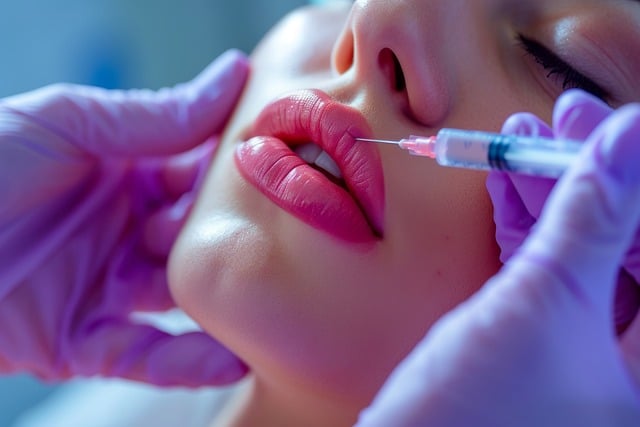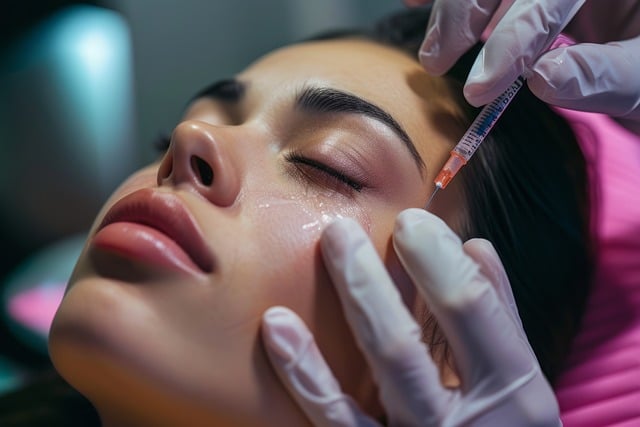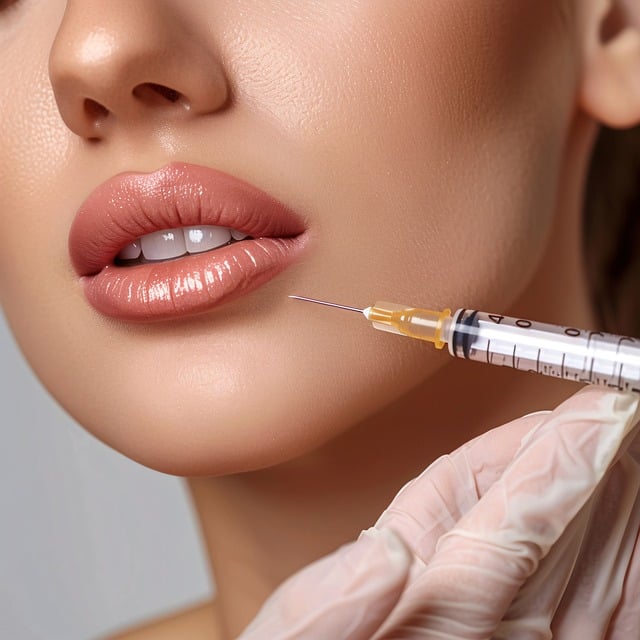This text compares Botox and dermal fillers as solutions for frown wrinkles, highlighting their distinct mechanisms and benefits. Key points include:
Botox: Relaxes facial muscles to prevent wrinkle formation (dynamic lines), offering 3-6 months of results with minimal side effects.
Dermal Fillers: Inject substances to add volume and smooth deep lines (static wrinkles), providing immediate but potentially riskier, temporary results lasting 6 months to years.
The text emphasizes the importance of understanding individual needs, treatment goals, and potential risks when choosing between these two popular non-surgical treatments for frown wrinkles.
“Uncover the secrets to banishing frown wrinkles with effective Botox treatments. This comprehensive guide explores the science behind frown lines, their impact on self-confidence, and how Botox emerges as a leading solution. We delve into the mechanism of action, dissecting its efficacy compared to dermal fillers, and guiding you through crucial factors in choosing the right treatment. Understanding safety measures and post-care is essential, ensuring optimal results that can last for years. Whether considering Botox or dermal fillers, this article equips you with knowledge to make an informed decision.”
Understanding Frown Wrinkles: Causes and Impact

Frown wrinkles, often referred to as glabellar lines or “11s,” are a common concern for many individuals who want to maintain a youthful appearance. Understanding their causes and impact is crucial when considering cosmetic treatments like Botox or dermal fillers. These wrinkles form between the eyebrows due to repeated facial expressions, such as frowning, squinting, or even stress. Over time, these expressions can lead to the breakdown of collagen and elastin fibers in the skin, resulting in permanent creases.
While both Botox and dermal fillers offer effective solutions, they target different aspects of wrinkle reduction. Botox, a protein derived from bacteria, temporarily paralyzes muscles, preventing them from contracting and forming wrinkles. On the other hand, dermal fillers boost the skin’s volume by injecting a substance into the affected area, smoothing out deep lines and adding definition back to the face. Knowing the differences between these treatments can help individuals make informed decisions about which one aligns best with their desired results.
The Role of Botox in Treating Frown Lines

Botox has emerged as a leading treatment for frown wrinkles, offering a non-surgical alternative to dermal fillers. Unlike fillers that plump and fill in wrinkles, Botox works by relaxing the muscles responsible for creasing the skin. By blocking the nerve signals that cause muscle contraction, Botox smooths out frown lines and forehead wrinkles, providing a more youthful appearance.
When considering Botox vs. dermal fillers for treating frown lines, it’s essential to understand their distinct mechanisms and effects. While fillers provide immediate results by adding volume, Botox delivers gradual, natural-looking results over several months. This makes Botox an excellent choice for those seeking subtle yet effective wrinkle reduction without the risk of over-plumping or an unnatural look.
How Does Botox Work for Frown Wrinkles?

Botox is a highly effective treatment for frown wrinkles, scientifically known as glabellar lines. It works by blocking the nerve signals that cause the muscles in your face to contract and form wrinkles. When injected into specific areas, Botox relaxes these muscles, smoothing out the skin and reducing the appearance of fine lines and furrows. This non-surgical approach offers a temporary yet noticeable result, making it a popular choice for those seeking to combat age-related facial wrinkles.
Unlike dermal fillers that add volume and lift to the skin, Botox focuses on preventing the formation of wrinkles by disrupting muscle activity. This difference is crucial when considering treatment options, as it allows individuals to choose between enhancing existing features (fillers) or reducing existing lines (Botox). Many people find that regular Botox treatments help them maintain a youthful appearance without the need for more invasive procedures.
Dermal Fillers: An Alternative Approach

When considering treatments for frown wrinkles, it’s essential to explore alternatives beyond Botox. One such option is dermal fillers, which offer a different approach to achieving smoother, younger-looking skin. Unlike Botox, which works by relaxing muscles to prevent wrinkling, dermal fillers physically fill in deep facial lines and wrinkles. These fillers are made from hyaluronic acid, a natural substance found in our bodies, making them safe and well-tolerated by most individuals.
The key difference between Botox vs dermal fillers lies in their mechanism of action. Botox prevents muscle contraction, which over time smooths out dynamic lines like frown lines and crow’s feet. On the other hand, dermal fillers add volume and contour to the skin, instantly reducing the appearance of static wrinkles. This alternative approach can provide immediate results, making it a popular choice for those seeking quicker solutions or wanting to avoid the repeated treatments often required with Botox.
Comparing Botox and Dermal Fillers for Frown Lines

When it comes to addressing frown wrinkles, both Botox and dermal fillers are popular choices. However, each treatment offers distinct advantages that cater to different preferences and needs.
Botox is a neurotoxin that relaxes muscles, preventing contraction and thus reducing the appearance of wrinkles. It’s particularly effective for dynamic lines caused by frequent facial expressions like frowning or squinting. The results usually last between 3-6 months, providing a temporary yet noticeable improvement. On the other hand, dermal fillers are made from hyaluronic acid or collagen, adding volume to the skin and smoothing out wrinkles. They’re ideal for deeper static wrinkles that persist even when muscles are at rest. Filler effects can last from 6 months to several years, making it a longer-term solution compared to Botox. The choice between Botox and dermal fillers depends on individual goals, budget, and desired duration of results.
Choosing the Right Treatment: Factors to Consider

When considering effective treatments for frown wrinkles, it’s crucial to understand that two leading options stand out: Botox and dermal fillers. Both have their merits, but understanding your specific needs and goals is key to making an informed decision. A comprehensive assessment with a qualified professional will consider several factors.
Firstly, the patient’s lifestyle and expectations play a significant role. For individuals actively seeking long-lasting results without frequent treatments, Botox often prevails due to its ability to relax muscle activity over several months. On the other hand, dermal fillers might be more appealing to those wanting quicker results for deeper wrinkles or looking for a temporary yet noticeable enhancement. Additionally, the severity and type of wrinkles will influence the choice between these two powerful cosmetic tools.
Safety and Side Effects: What You Need to Know

When considering Botox for frown wrinkles, it’s crucial to understand safety and potential side effects. Unlike dermal fillers, which can cause issues like lump formation or asymmetry, Botox is generally well-tolerated. However, temporary redness, swelling, or mild bruising at the injection site are common. Rarer but more serious side effects include headache, muscle weakness around the mouth, or difficulty swallowing. It’s essential to choose a qualified provider for your treatment, as proper technique minimizes these risks.
Unlike Botox, dermal fillers can shift over time, requiring touch-ups. Botox, on the other hand, typically lasts 3-6 months, offering longer-term results without the need for frequent injections. While both procedures have their advantages and considerations, understanding these safety aspects is key to making an informed decision between Botox vs dermal fillers for treating frown wrinkles effectively and safely.
Post-Treatment Care and Results Expectations

After your Botox treatment for frown wrinkles, proper post-care is essential to ensure optimal results and minimize potential side effects. It’s crucial to follow your healthcare provider’s specific recommendations, but generally, avoiding strenuous activities, direct sunlight, and heavy exercise for a few days is advised. You may experience mild redness, swelling, or discomfort at the injection sites, which typically subside within a short time. Applying a cold compress can help alleviate any post-procedure discomfort.
When comparing Botox to dermal fillers, results differ significantly. Botox primarily prevents muscle contractions that cause dynamic frown lines, offering a smoother appearance that can last for several months. Dermal fillers, on the other hand, add volume and lift to the skin, providing a more immediate but temporary effect. Fillers may be a better option for deeper wrinkles or those seeking a more substantial improvement. Understanding these distinctions helps patients make informed decisions tailored to their aesthetic goals.
Long-Term Maintenance: Keeping Results Lasting

Many patients wonder how long the results of Botox treatments last, especially when considering its effectiveness in smoothing frown wrinkles compared to dermal fillers. It’s important to understand that while both procedures offer significant benefits, they serve different purposes and have varying timelines. On average, the effects of Botox can last between 3 to 6 months, depending on several factors such as muscle activity, age, and individual metabolism. This makes it an ideal choice for those seeking a temporary yet noticeable reduction in dynamic wrinkles, especially around the eyes and forehead.
To maintain these results, regular top-up treatments are often recommended. This is where Botox stands out against dermal fillers. Fillers can last anywhere from 6 months to several years, but they aren’t as effective in addressing dynamic lines caused by muscle contractions. For long-term maintenance, patients usually require Botox injections every 3-4 months to prevent the return of wrinkles. Regular touch-ups ensure that the treatment stays effective and allows for better control over the area’s appearance over time.
